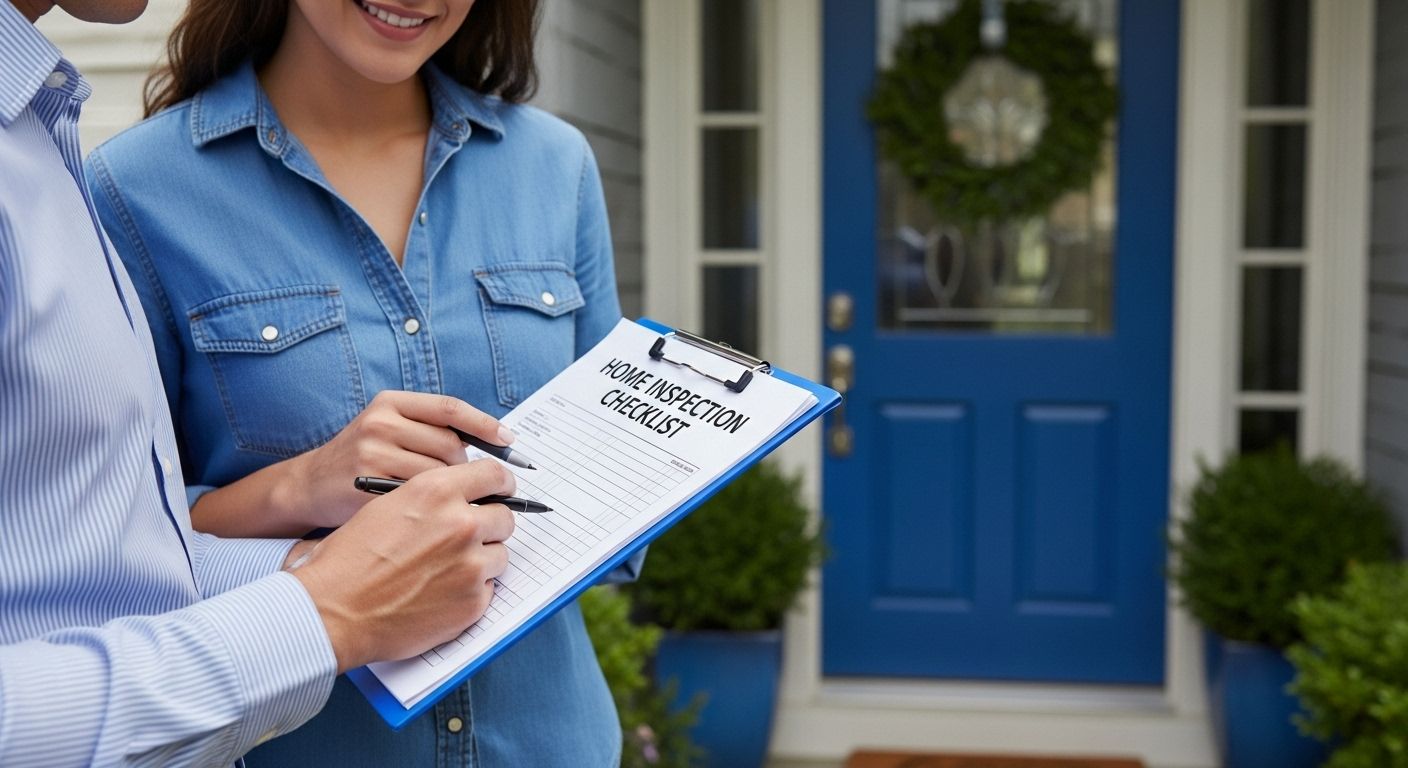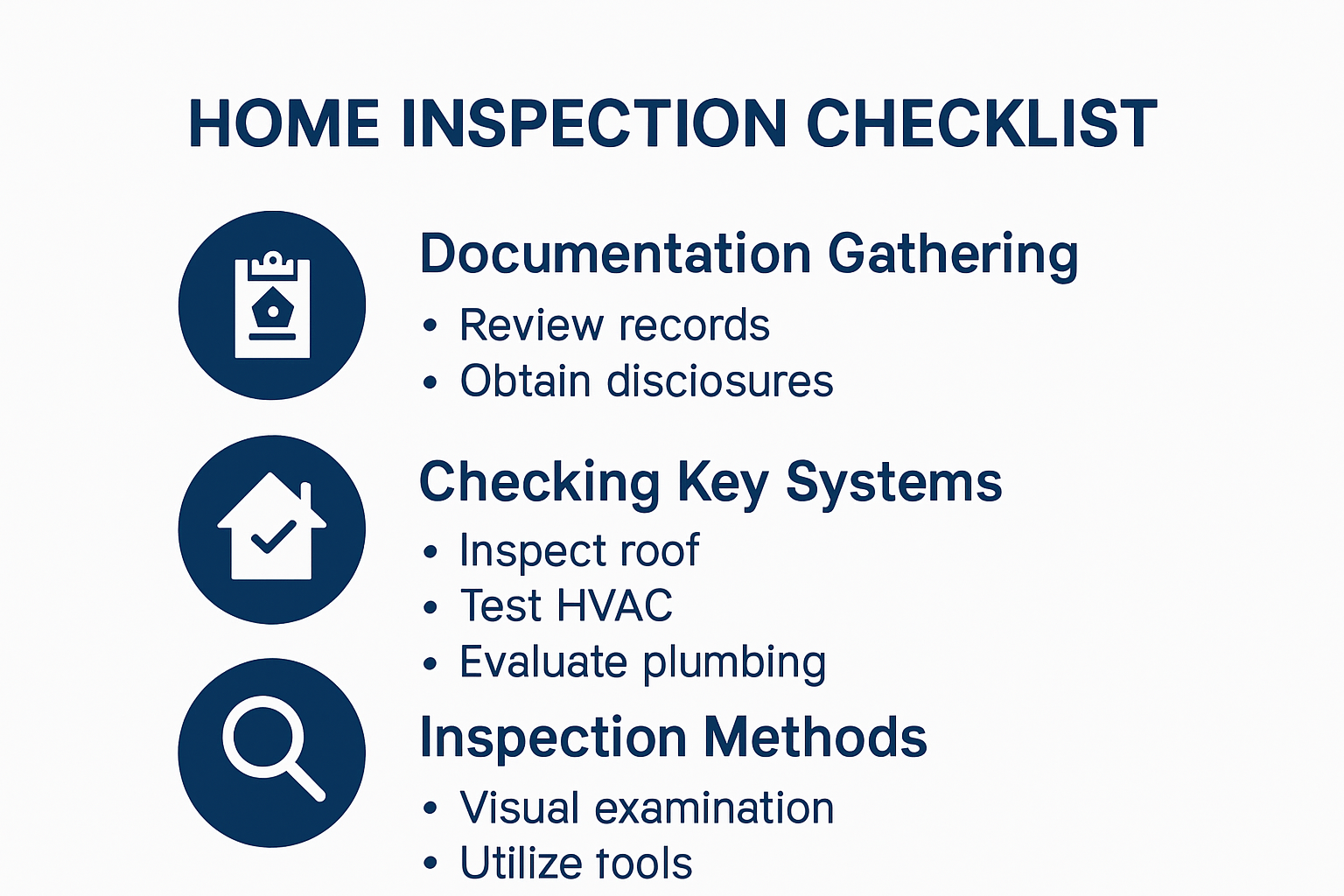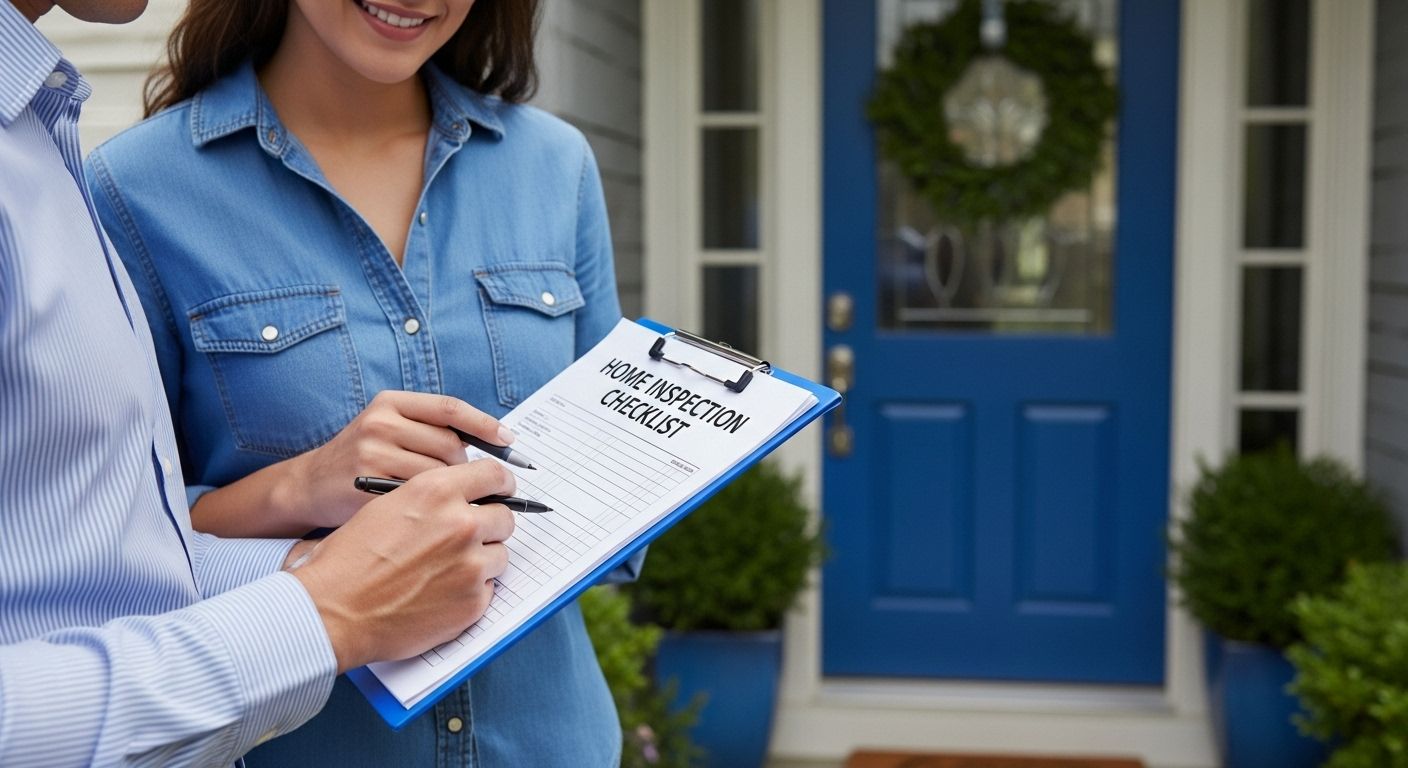Essential Home Inspection Checklist for Buyers & Sellers
Preparing for a home inspection is about more than making sure your house looks tidy. In Oakland County, homes come in all shapes and ages, from waterfront gems in West Bloomfield to historic treasures in Farmington Hills. You might think the process starts when the inspector arrives, but the true game begins much earlier and hinges on the details you gather. Professional inspectors report spending an average of three to four hours evaluating a typical home, and the difference between a smooth inspection and a stressful one often comes down to careful documentation and smart preparation. Most homeowners never realize that what happens before the inspection even starts can completely change the outcome.

Table of Contents
- Step 1: Gather Necessary Documentation And Resources
- Step 2: Prepare A Comprehensive List Of Inspection Areas
- Step 3: Conduct The Home Inspection Methodically
- Step 4: Document Findings With Photos And Notes
- Step 5: Assess And Prioritize Repairs Or Improvements
- Step 6: Create A Summary Report For Buyers Or Sellers
Quick Summary
| Key Point | Explanation |
|---|---|
| 1. Collect Comprehensive Documentation | Assemble building permits, renovation records, and maintenance logs for efficient inspections and historical context. |
| 2. Prepare an Inspection Checklist | Create a detailed checklist to cover all critical home systems and structural components, ensuring nothing is overlooked. |
| 3. Conduct Inspections Methodically | Start from the exterior and move inwards, documenting issues systematically for thorough evaluation. |
| 4. Document Findings with Photos | Use high-quality images and detailed notes to record inspection results, providing concrete evidence for future reference. |
| 5. Prioritize Repairs Strategically | Categorize issues by urgency—immediate safety, critical functionality, and cosmetic only after addressing top concerns. |
Step 1: Gather Necessary Documentation and Resources
Preparing for a home inspection begins long before the inspector arrives at your property. Comprehensive documentation serves as the foundation for a smooth and thorough evaluation, providing critical insights into your home’s history, maintenance, and potential areas of concern. In Oakland County, Michigan, where home characteristics can vary widely from waterfront properties in West Bloomfield to historic homes in Farmington Hills, having a complete set of documents is crucial.
Start by collecting key paperwork that tells your home’s story. Homeowners should assemble a comprehensive folder including original building permits, renovation records, appliance manuals, warranty information, and maintenance logs. According to the International Association of Certified Home Inspectors, these documents provide inspectors with valuable context about the property’s history and potential improvements.
Your documentation packet should include several critical items that offer a comprehensive view of your home’s condition and history:
- Property survey and plot plans
- Original construction blueprints
- Recent utility bills showing energy efficiency
- Records of major system replacements (HVAC, roof, electrical)
- Permit documents for any significant renovations
For sellers in areas like Bloomfield Hills or Commerce Township, having organized documentation can significantly streamline the inspection process and demonstrate proactive home maintenance. Buyers will appreciate the transparency, and inspectors can more efficiently assess the property’s condition.
Take time to organize these documents chronologically and create digital backups. Consider scanning important papers and storing them securely in cloud storage or on a dedicated external hard drive. This approach ensures you have accessible records even if physical documents are misplaced.
Homeowners should also prepare the physical space for the inspection. Ensure clear access to key areas like electrical panels, attic spaces, crawl spaces, and major mechanical systems. Remove any items blocking access to these critical inspection points. By preparing thoroughly, you transform a potentially stressful process into a smooth, informative evaluation of your home’s condition.
Step 2: Prepare a Comprehensive List of Inspection Areas
Creating a comprehensive home inspection checklist transforms a potentially overwhelming process into a structured, methodical evaluation. In Oakland County, where home styles range from historic Farmington Hills bungalows to modern West Bloomfield waterfront properties, understanding the full scope of inspection areas becomes critical for both buyers and sellers.
Systematic documentation is key to a thorough home inspection. According to New York State Standards of Practice for Home Inspectors, a comprehensive inspection covers multiple critical home systems and structural components. Homeowners and potential buyers should develop a detailed checklist that encompasses every aspect of the property, ensuring no potential issue goes unnoticed.
Begin by breaking down your inspection into primary categories that cover the entire property. Structural integrity demands careful examination of foundational elements, including basement walls, floor systems, and load-bearing structures. Pay special attention to signs of potential settlement, water damage, or structural compromise that might be more prevalent in older Oakland County neighborhoods.
The mechanical systems represent another crucial inspection area. This includes electrical panels, plumbing infrastructure, heating and cooling systems, and major appliances. In Michigan’s variable climate, these systems undergo significant stress, making their evaluation paramount. Look for signs of wear, potential code violations, or outdated components that might require immediate replacement.
Your comprehensive list should include specific inspection points for both interior and exterior elements:
- Roof condition and potential water damage
- Foundation and structural stability
- Electrical system functionality
- Plumbing network and water pressure
- HVAC system performance
- Windows and door installations
- Insulation and ventilation
- Exterior siding and trim
Remember that a thorough inspection goes beyond surface-level observations. Professional inspectors will probe deeper, examining hidden systems and potential long-term maintenance issues. For homeowners in areas like Bloomfield Hills or Commerce Township, where property values can be significant, this detailed approach provides crucial insights into the home’s true condition.
By developing a meticulous, comprehensive inspection checklist, you transform a potentially stressful process into an opportunity for informed decision-making. Each documented area becomes a piece of a larger puzzle, revealing the true story of your property’s condition and potential future maintenance needs.
The following checklist table summarizes the main home inspection areas you should cover to ensure a methodical and thorough assessment. Use this as a quick reference to verify that each critical element has been evaluated during your walk-through.
| Inspection Area | What to Check | Notes/Focus |
|---|---|---|
| Roof & Exterior | Roof condition, gutters, siding, drainage | Look for water damage or wear |
| Foundation & Structure | Walls, floors, basement, support systems | Check for cracks, settling, moisture |
| Electrical System | Outlets, panels, breakers | Look for code compliance and safety |
| Plumbing | Pipes, fixtures, water pressure | Test for leaks and water flow |
| HVAC | Heating, cooling, ventilation | Assess performance and maintenance |
| Windows & Doors | Operation, seals, frames | Inspect for drafts and damage |
| Insulation & Ventilation | Attic, crawl spaces, exhaust fans | Verify energy efficiency |
| Interior Rooms | Floors, walls, ceilings | Look for signs of moisture, pests |
Checking these areas thoroughly reduces the chance of missing major defects.

Step 3: Conduct the Home Inspection Methodically
Home inspections represent a critical moment in real estate transactions, particularly in diverse markets like Oakland County, where properties range from historic Farmington Hills bungalows to modern West Bloomfield waterfront homes. Methodical execution transforms this potentially complex process into a systematic evaluation of a property’s true condition.
According to InterNACHI’s Home Inspection Checklist, a comprehensive inspection requires a structured, deliberate approach. Professional inspectors recommend starting with exterior assessments and progressively moving inward, ensuring no critical element escapes thorough examination.
Begin with the property’s exterior, carefully examining the foundation, roofing, siding, and landscaping. Look for signs of water drainage issues, foundation settling, or structural compromise. In Michigan’s variable climate, exterior elements undergo significant stress, making this initial assessment crucial. Pay special attention to grading around the foundation, checking that soil slopes away from the home to prevent potential water infiltration.
Transition from exterior to interior inspections with meticulous precision. Systematic room-by-room evaluation allows for comprehensive documentation of potential issues. Start with high-traffic areas like kitchens and bathrooms, where plumbing and electrical systems converge. Check under sinks for water damage, test electrical outlets, and examine flooring for signs of wear or potential moisture problems.
Critical inspection areas demand focused attention:
- Structural integrity of walls and ceilings
- Functionality of electrical systems
- Condition of plumbing networks
- Performance of heating and cooling systems
- Window and door seal effectiveness
- Potential signs of pest infestation
Professional inspectors typically spend three to four hours thoroughly examining a typical home, depending on the property’s size and complexity. For buyers and sellers in areas like Bloomfield Hills or Commerce Township, this time investment provides invaluable insights into the property’s true condition.
Documentation becomes your strongest ally during the inspection process. Take comprehensive notes, capture detailed photographs, and request specific explanations from the inspector about any identified issues. These records serve as critical reference points for future maintenance, potential negotiations, or understanding the home’s long-term care requirements.
Remember that a methodical home inspection is more than a checklist—it’s a comprehensive story about the property’s health, revealing its strengths, potential challenges, and future maintenance needs. By approaching the process with patience and systematic thoroughness, you transform a potentially stressful experience into an informative journey of property discovery.
Step 4: Document Findings with Photos and Notes
Documenting home inspection findings transforms abstract observations into concrete, actionable information. In Oakland County’s dynamic real estate market, where properties range from vintage Farmington Hills homes to modern Commerce Township developments, comprehensive documentation becomes your strategic advantage.
According to the Virginia Administrative Code, professional inspection reports must provide detailed descriptions of inspected components and observed defects. This principle guides homeowners and buyers in creating a thorough record of the property’s condition.
Photographic evidence serves as the cornerstone of effective documentation. Use a high-resolution smartphone or digital camera to capture clear, well-lit images of potential issues. Focus on creating context by including wide-angle shots that show the location of specific problems, followed by close-up images that reveal intricate details. For instance, when documenting a potential foundation crack, first capture the entire wall, then zoom in to show the crack’s precise dimensions and characteristics.
Written notes complement photographic evidence, providing critical context and professional interpretation. Develop a systematic approach to note-taking that includes precise location descriptions, measurements, and potential implications of observed issues. Use a dedicated notebook or digital note-taking app to ensure your documentation remains organized and easily referenced.
Your documentation strategy should include:
- Date and time of inspection
- Specific location of each observed issue
- Detailed description of potential problems
- Recommended follow-up actions
- Estimated repair or replacement costs
Professional inspectors recommend creating a digital archive of your findings. Organize photos and notes into clearly labeled folders, potentially using cloud storage for easy access and backup. This approach ensures that critical information remains accessible, even if physical documents are misplaced.
For homeowners in areas like Bloomfield Hills or West Bloomfield, where property values can be substantial, thorough documentation can be instrumental during negotiations or future maintenance planning. Each photograph and note becomes a piece of evidence that tells the comprehensive story of your property’s condition.

Remember that effective documentation is more than just collecting information—it’s about creating a clear, actionable narrative that empowers informed decision-making. By approaching this step with precision and care, you transform a home inspection from a simple assessment into a strategic tool for understanding and protecting your property investment.
Step 5: Assess and Prioritize Repairs or Improvements
Transforming home inspection findings into a strategic action plan requires careful analysis and thoughtful prioritization. In Oakland County’s diverse real estate landscape, from historic Farmington Hills bungalows to modern Bloomfield Hills estates, understanding how to effectively categorize and address property issues becomes crucial for maintaining home value and safety.
Financial and structural considerations drive the repair prioritization process. Begin by separating discovered issues into three critical categories: immediate safety concerns, critical functional repairs, and cosmetic improvements. Safety issues demand immediate attention, representing potential risks to the home’s inhabitants and structural integrity.
Immediate safety concerns might include electrical system deficiencies, structural foundation problems, or significant water damage that could compromise the building’s core systems. These repairs should be addressed without delay, potentially requiring professional intervention from licensed contractors specializing in Oakland County’s unique housing market.
Critical functional repairs represent the next tier of prioritization. These typically involve systems that directly impact the home’s livability and efficiency, such as:
- Roof and exterior water intrusion prevention
- Heating and cooling system functionality
- Plumbing network integrity
- Electrical system upgrades
- Foundation and structural stability issues
Budget planning becomes a strategic component of repair prioritization. Homeowners should obtain multiple professional quotes for significant repairs, comparing costs, timelines, and potential long-term benefits. In areas like West Bloomfield and Commerce Township, where property values can be substantial, investing in quality repairs can significantly impact future resale potential.
Cosmetic improvements, while important for aesthetic appeal, should be considered last. These might include updating paint, replacing flooring, or modernizing fixtures. While these enhancements contribute to home value, they do not compromise the property’s fundamental safety or functionality.
To help homeowners and inspectors track inspection priorities, the table below organizes potential issues into clear categories along with notes on urgency and focus. This format helps turn a long list of problems into an actionable plan.
| Category | Description/Examples | Priority Level |
|---|---|---|
| Immediate Safety Concerns | Electrical deficiencies, major foundation issues, severe water damage | High |
| Critical Functional Repairs | Roof leaks, HVAC failures, plumbing leaks, outdated electrical panels | Medium-High |
| Cosmetic Improvements | Paint updates, fixture upgrades, flooring replacement | Low |
This system helps ensure urgent issues are addressed first, with cosmetic updates following once critical repairs are complete.
Consider creating a detailed spreadsheet that tracks each identified issue, including estimated repair costs, potential contractors, and projected timelines. This systematic approach transforms overwhelming inspection findings into a manageable, strategic renovation plan.
Remember that prioritizing repairs is not just about immediate fixes but about long-term home maintenance and value preservation. By approaching repairs methodically, homeowners can protect their investment, ensure family safety, and maintain their property’s structural and aesthetic integrity. Each repair becomes a strategic decision that contributes to the home’s overall health and future marketability.
Step 6: Create a Summary Report for Buyers or Sellers
Transforming detailed home inspection findings into a comprehensive, clear summary report represents the critical final step in the home inspection process. In Oakland County’s dynamic real estate market, where properties range from historic Farmington Hills craftsman homes to modern Bloomfield Hills estates, a well-crafted report can significantly impact transaction negotiations and future maintenance planning.
According to the International Association of Certified Home Inspectors, a professional home inspection report must systematically identify material defects within specific home systems and components. Clarity and precision become your primary objectives when compiling this crucial document.
Organizational structure determines the report’s effectiveness. Begin with a concise executive summary that highlights the most significant findings, providing an immediate overview of the property’s condition. This section should quickly communicate critical issues that might impact the home’s value, safety, or functionality. For buyers and sellers in areas like West Bloomfield and Commerce Township, this snapshot can be instrumental in understanding potential investment requirements.
Each section of the report should follow a consistent, easy-to-understand format. Divide findings into clear categories that reflect the home’s major systems and structural components. Use a standardized rating system that helps readers quickly comprehend the severity and potential impact of each identified issue.
Key report components should include:
- Detailed description of each identified issue
- Photographic evidence documenting problems
- Estimated repair or replacement costs
- Recommended timeline for addressing concerns
- Potential long-term implications of unresolved issues
Professional presentation matters. Use clean, professional formatting with clear headings, consistent fonts, and high-quality images. Include precise location information for each documented issue, ensuring that readers can easily understand where and what the problem involves.
Consider adding a supplementary section offering maintenance recommendations. This forward-looking approach demonstrates value beyond immediate inspection findings, providing homeowners with proactive strategies for preserving their property’s condition and value.
Remember that a summary report is more than a document—it’s a strategic communication tool that bridges inspection findings with informed decision-making. By crafting a report that is both comprehensive and accessible, you empower buyers and sellers with the knowledge needed to make confident real estate decisions.
Ready to Turn Your Home Inspection Insights Into Action?
You have followed a detailed home inspection checklist and uncovered essential details about your property in Oakland County. Maybe you are feeling overwhelmed by what needs fixing first or concerned about how your home’s condition could impact a sale or purchase. The process can seem stressful, especially with so many moving parts like documentation, critical repairs, and prioritizing tasks.
Whether you are preparing to list your house or searching for the right home to buy, you deserve expert help translating inspection findings into smart market decisions. Tom Gilliam brings over 20 years of local market expertise and has guided hundreds of clients in Farmington Hills, West Bloomfield, Commerce Township, and beyond through this exact process. From deciphering inspection reports to negotiating the right repairs, Tom’s proven approach gives you a clear path forward.

Do not let hidden problems or confusing checklists hold you back from your goals. Connect with Tom Gilliam, trusted Oakland County Realtor, and get the personalized strategies you need to turn your inspection insights into a successful transaction. Visit homes2moveyou.com now to take the stress out of your next move.
Frequently Asked Questions
What should I gather before a home inspection?
To prepare for a home inspection, gather important documentation such as original building permits, renovation records, appliance manuals, warranty information, maintenance logs, and utility bills. This provides valuable context about the property’s history and condition.
How can I create an effective home inspection checklist?
An effective home inspection checklist should include categories such as structural integrity, mechanical systems, and specific inspection points like roof condition, plumbing network, and electrical functionality. This will ensure no aspect of the property is overlooked during the inspection.
What are common issues to look for during a home inspection?
Common issues to look for during a home inspection include signs of water damage, foundation cracks, outdated electrical systems, and the condition of the HVAC system. It’s important to document any findings thoroughly for future reference.
How should I prioritize repairs after a home inspection?
Repairs should be prioritized based on their severity, categorizing them into immediate safety concerns, critical functional repairs, and cosmetic improvements. Focus on addressing safety issues first, followed by functional repairs that impact livability, and lastly, cosmetic enhancements.
Recommended
- Novi Michigan Homes For Sale | Novi Realtor - Homes2MoveYou
- Norhville Archives - Homes2MoveYou.com
- Qualified Oakland County MI REALTOR® Archives - Homes2MoveYou.com
- oakland county home as is Archives - Homes2MoveYou.com
- Essential Home Inspection Guide for Real Estate Pros - Lead Linker
- Insurance Inspection Requirements 2025: Guide for Home and Car Owners - Savvy Insurance




